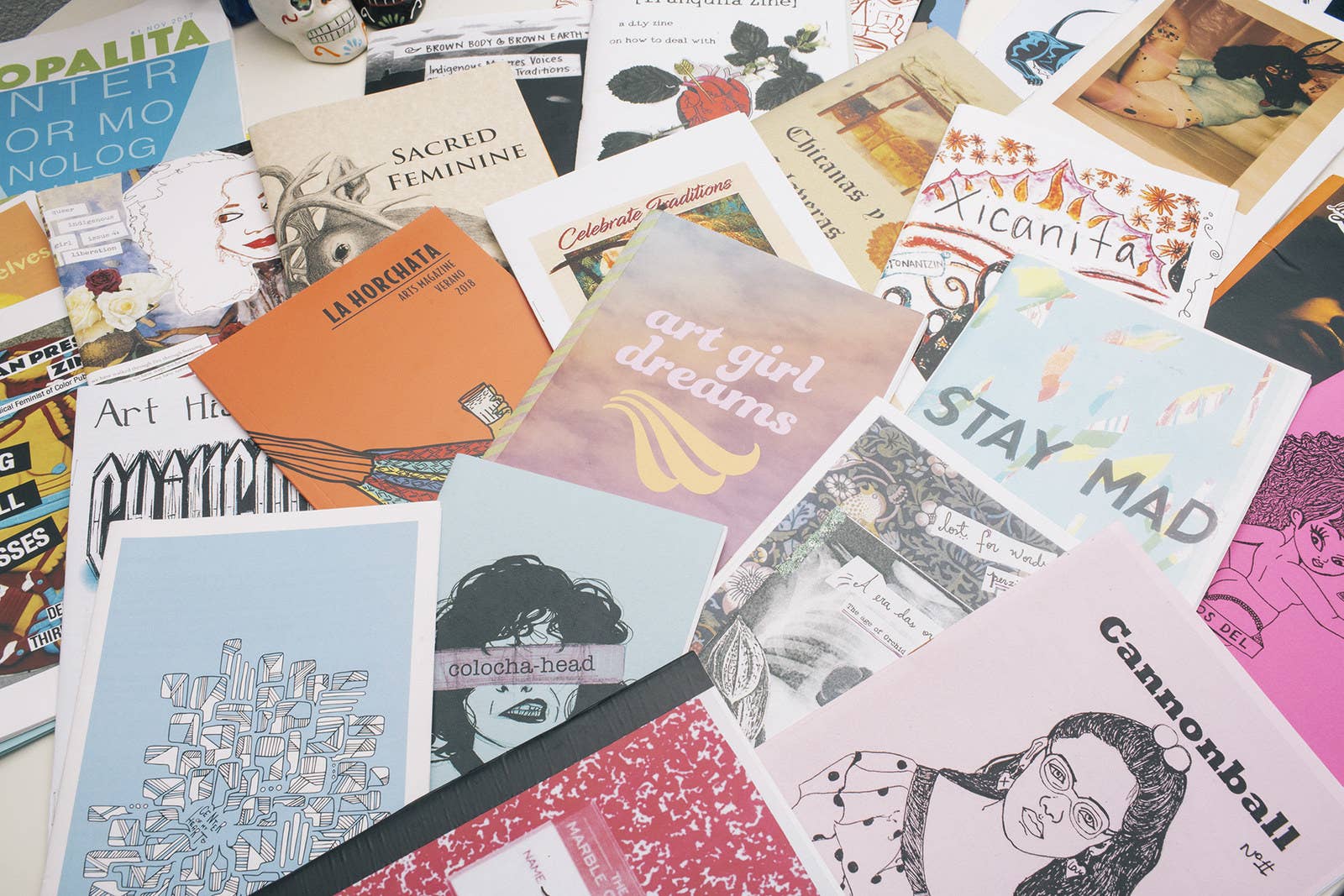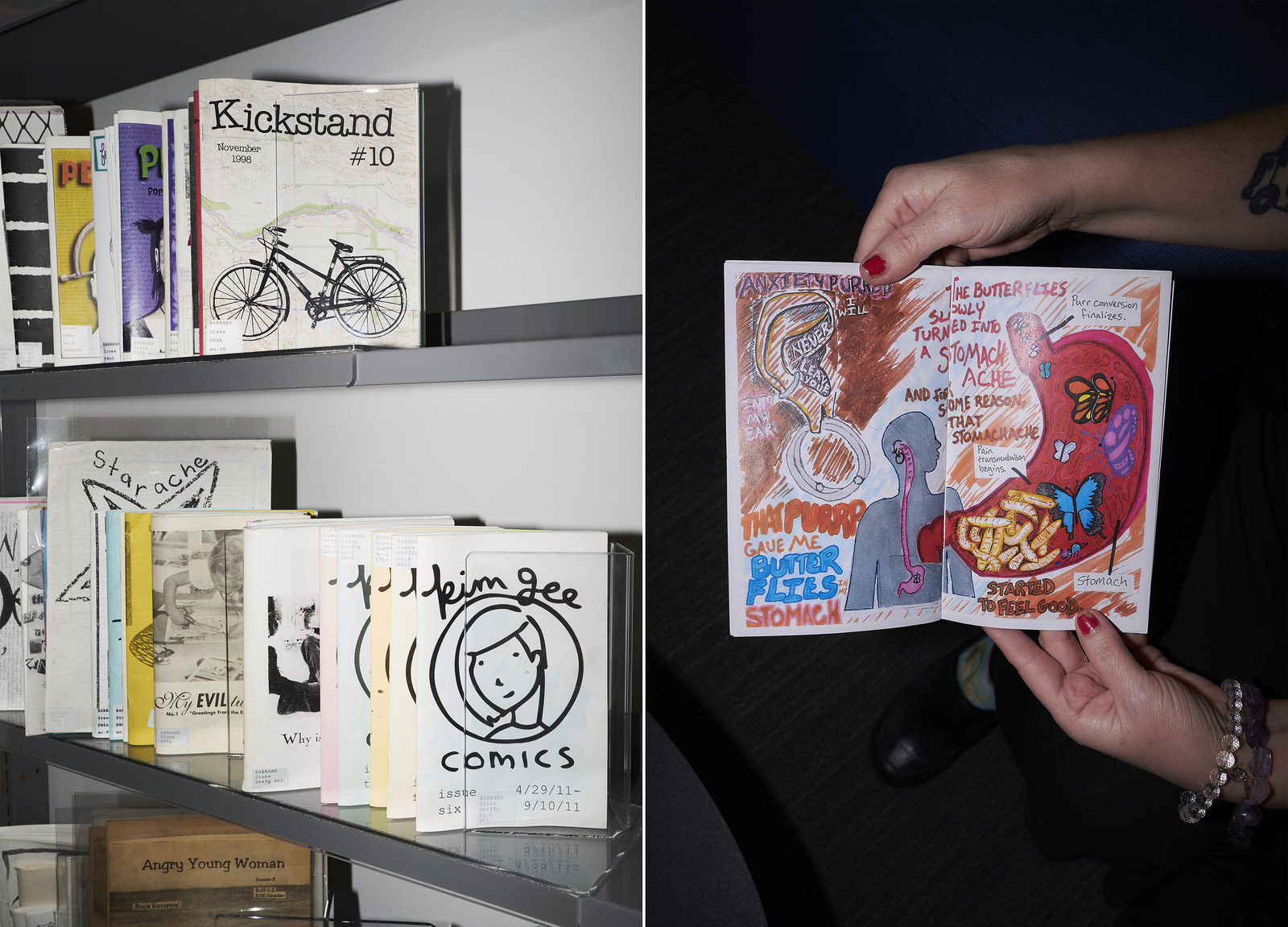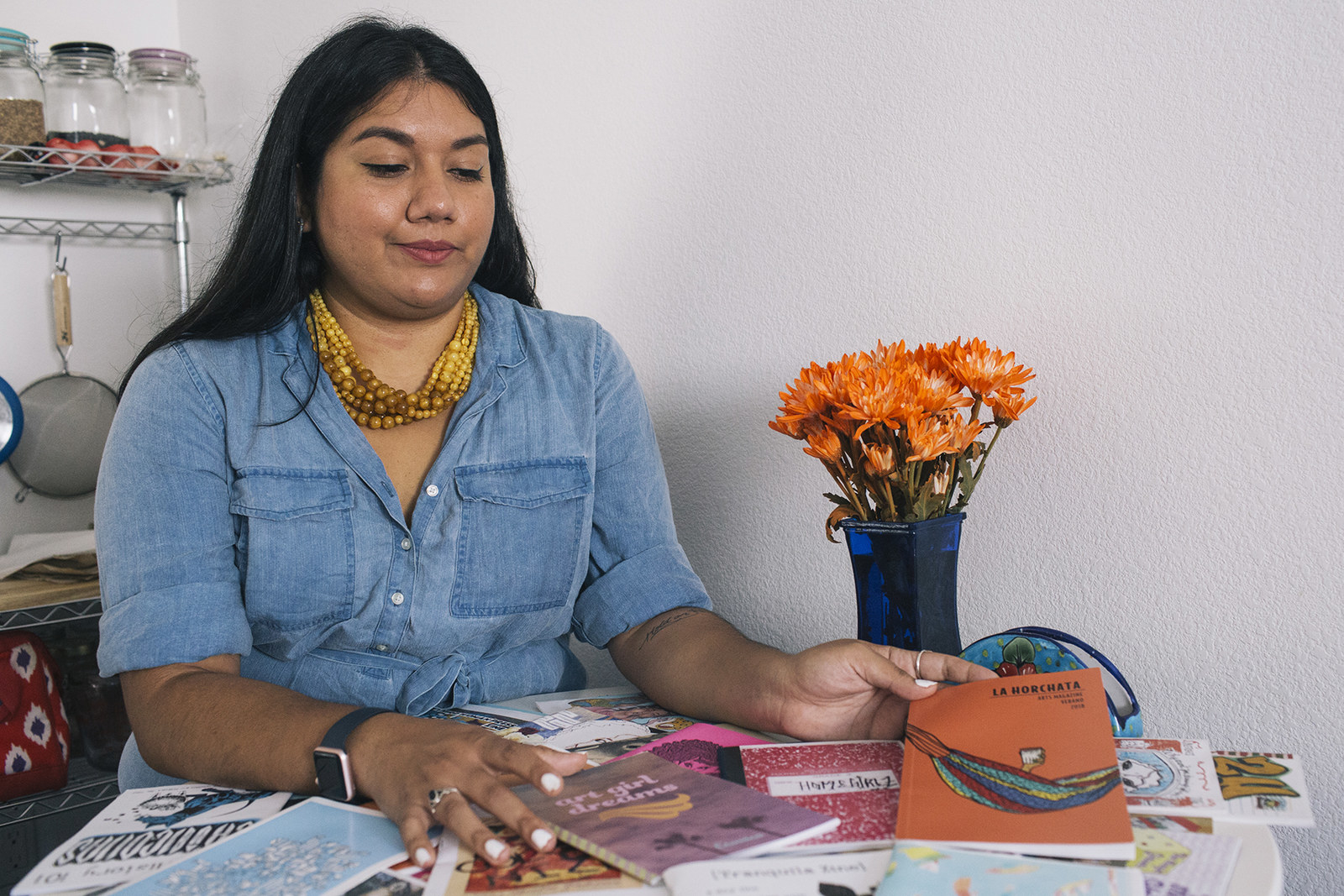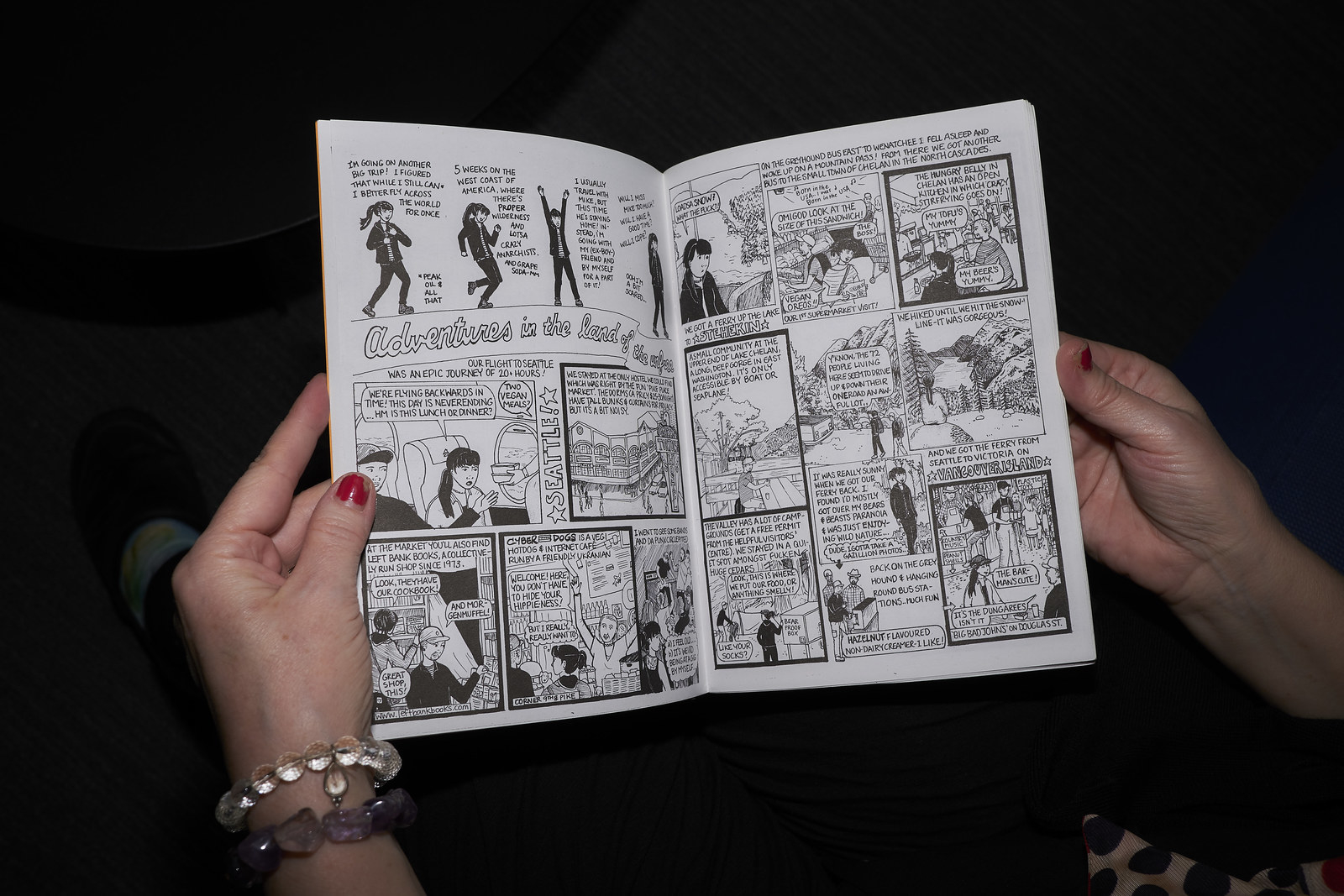
Sweaty music venues, photocopiers, riot grrrls — these are the images that likely come to mind when you think of zines. Though the women-fronted punk rock movement of the early ’90s is often thought of as the time when zine culture thrived, the reality is that zines have long been a way for marginalized communities to record their stories, spread information, and organize. From the wood-printed abolitionist pamphlets created by the American Anti-Slavery Society in the 1830s to La Catrina satirical cavalera cartoons made and distributed by José Guadalupe Posada in the 1900s to the handouts the Black Panther Party disseminated in the ’60s, zine culture as we know it today was created by, and built to fit, the political and social needs of communities of color.
That these zines are often handmade with a relatively small self-publication circulation means they provide a great accessible space for anyone to create work on their own terms. It also means they tend to be rare, running the risk of being easily lost to history. But in libraries, colleges, and museums around the world there is a movement to archive and record this vital work, which could change the way we understand and interact with zines as a whole.
When Jenna Freedman was studying for her master’s in library science at the University of South Florida, she had little experience with the wide-ranging scope of the art form, having only experimented with zines a bit in the ’90s. That changed after a chance meeting with famed Latinx zinester Celia C. Pérez, whose work primarily explores the punk scene. “I didn't really find my love for zines until Celia gave me one of hers,” Freedman said. “It was a truly lovely blend of personal and political. It had a little bit of art but it wasn’t artsy.”

That introduction didn’t just spark love; it inspired a career. In 2003, Freedman established the zine library at Manhattan’s Barnard College, where she is still zine librarian. Today, the collection consists of over 10,000 zines and focuses heavily on material created by marginalized communities, with topics as varied as mothers and daughters documenting holidays together to searing political collections about racism in punk rock. Because Freedman’s introduction to zines was through the work of Pérez, it was always imperative to her that the library represent the multitudes of work of women of color: “I think it’s important that we both acknowledge, but also push back on, the narrative of zines and punk culture being completely white.” Students from Columbia University and Barnard can access the zines and borrow them for up to a semester at a time, but if you’re not enrolled you can make an appointment to visit the library and view the collection.
This vital research and archiving is taking place all over the country. Over the past two decades, historians and librarians have been archiving zines in the desire to expand our understanding of the medium, in spaces like the Main Zine Collection in Pittsburgh's Carnegie Library, San Francisco Public Library’s Little Maga/Zine Collection, the Library Workers Zine Collection at the iSchool Library at the University of Wisconsin-Madison, and many more. This effort is ever evolving and continuously growing, creating an accessible record of alternative historical narratives — especially important in a society where entire communities are marginalized and written out of history. These collections enable these stories to be shared and protected, where they would likely otherwise be ignored and erased.

In 2015, zinester and librarian Ziba Zehdar established the first zine collection within the Long Beach Public Library system in California. It is currently home to almost 1,000 zines, housed in the vibrant and bustling downtown Long Beach Main library. Senior librarian Alana LaBeaf now runs the collection after Zehdar left last year, and found it to be a perfect way to encourage new audiences to visit. The library often runs zine-making workshops, and librarians take zines with them during outreach visits. “It’s a nice fit for the community services department, since we deal with services to specific community groups,” LaBeaf said. “Zines truly are a reflection of the community. I think [the collection] draws new people to the library who might not come otherwise.”
Many of the zines in the Long Beach Public Library collection focus on identity, self-care, and mental health, in ways that aren’t usually addressed in the library’s traditional catalog. “Zines such as But You Don’t Look Sick: A Zine About Invisible Illnesses and Disabilities in the Workplace — a compilation zine from Queer Anxiety Babiez Distro — might not have the medical perspective that a book on the subject would likely provide, but it does provide some moral support or sense of belonging for anyone reading it,” said LaBeaf.
That solidarity and representation is something that visitors to Long Beach Public Library can expect to find among its zines, with a vast collection of brilliant and eclectic works like Roots: Asian American Movements in Los Angeles 1968-1980s, the compilation zine based on the Chinese American Museum’s exhibition of the same name, or Refugee Art Project, which was created through workshops at Australia’s Villawood Detention Centre. It’s rare that you get to explore the experiences of people on the other side of the world through art that they make with their own hands, but the Long Beach library affords that access. Zines can give space to stories that aren’t often told, because their creators aren’t held back by financial constraint, or blocked by a publishing industry that remains exceedingly white.

The power of zines to be records of frequently ignored and underrepresented narratives was something that drew Marissa Del Toro to begin researching the art of zines and zine culture. A Chicana art historian who received her master’s in art history from the University of Texas at San Antonio, Del Toro was a graduate intern at the Getty Research Institute when she became interested in zines. “I started collecting physical copies of zines around 2013 or 2014, but I’d been previously following zinesters and zine collectives on social media, specifically Tumblr. I noticed that a lot of the zinesters — especially Latinx zinesters — were creating them as a space to express themselves freely, without restrictions on their art, and on their own terms.”
In revisiting the work and spaces of those who came before her, Del Toro was inspired to fight for the expansion of zine culture — specifically to include the works of Latinx artists and writers instrumental in Latin American history. She mentions José Guadalupe Posada, who created La Catrina from 1910 to 1913 — a collection of zinc-etched lithographs that critiqued Mexicans who adopted European aristocratic traditions and aspired to a European lifestyle, and that paved the way for the countercultural role of zines that we see today.
Another vital group that has inspired Del Toro’s work are the radical organizers who created the magazine La Raza in 1970s Los Angeles, a publication which frequently addressed issues such as police brutality, segregation, and a wildly racist educational system. La Raza is also remembered for the incredible photography that filled its pages, showcasing the struggle and lives of the collective of activists who created it.
“These types of zine-related materials laid a foundation of countercultural histories that had transformative effects culturally, socially, and politically,” Del Toro explained. Del Toro’s work in recognizing early zines by Latinx creators — and, over at Barnard, Freedman’s work with Feminist Zinefest in elevating zines by writers and artists of color — broadens the scope.

Accessing these collections can have a huge impact on zine creators, too. Zahra Swanzy is the radical artist, activist, and creative mind behind Roadfemme, an intersectional newspaper-style zine focusing on the lives and thoughts of women from all walks of life. A “tomboy” who “was and still [is] anti everything,” Swanzy became obsessed with the medium when she discovered London’s Feminist Library. The independently run archival library has the largest collection of women’s liberation literature and zines in the UK, which includes around 5,000 pamphlets, books, and zines dating back to 1990. The library has been active in south London since 1975.
For Swanzy, being able to tap into this resource was empowering, but as a lot of the pamphlets were from the ’60s and ’70s it seemed that the discourse and conversation around feminism hadn’t really moved on. Swanzy found many of the texts to be outdated, rife with the problematic aspects of early-stage feminism, and “written from an exclusionary lens.” She was disheartened — and inspired to do better. “I chose to build upon what I learned there,” Swanzy said.
Each issue of Roadfemme showcases raw, honest storytelling in a variety of creative forms, exploring identity, sexuality, and oppression in illustration, photography, and personal essays. “Since its conception, Roadfemme has focused on the intersections within feminism,” Swanzy said, “and allowing those marginalized voices to take up more space.”
One of those voices is Dawn Wing, a reference and instruction librarian at Metropolitan State University in Saint Paul, Minnesota, who also happens to be a zine maker. As a librarian, she sees firsthand the gaps in representation; as a creator, she does her best to fill some of them. Her work is collage- and illustration-based, slipping seamlessly between personal storytelling and educational biographies. She’s currently working on a story about two Chinese American translators and activists, Tien Fu Wu and Tye Leung Schulze, two women Wing describes as “super fierce.”
“My hope is to publish their collective biographies so that their narratives are available to a wider audience,” Wing said. “During these times, we need to be inspired by and connected to as many stories of fearless, courageous women of color as we can!”

At their roots, zines are a way of disseminating information and narratives that mainstream channels have rejected. They are a space for communities to come together to record and share their own stories, whether they’re about family, politics, culture, or anything in between. As private and public institutions make room for zines and the people who create and enjoy them — from libraries to zine fests, colleges to art museums — that space extends beyond the zines themselves. These growing physical spaces nurture art and creativity within communities that are often ignored. And as more libraries integrate zines into their collections, spreading awareness of zine culture as a whole, the pool of stories will grow larger and more diverse.
It would be very easy for the work of people like Swanzy and Wing to be lost if it wasn’t for historians like Del Toro and librarians like Freedman, whose love for zines comes from a place of wanting to preserve and center alternative historical narratives. “What I love about the zine library is that it’s a majority-women, nonbinary, and trans space. It’s default queer, it’s intentionally of color,” said Freedman. “I think it’s so important and wonderful to be able to walk into a space where you’re the default.”
“Creating zines is a radical act,” Swanzy explained. “People create zines to provide an outlet for their inner voice in a raw way. That should be treasured.” ●
Rosie Knight is an entertainment journalist who makes comics and zines.
